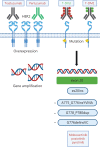Targeting the EGF receptor family in non-small cell lung cancer-increased complexity and future perspectives
- PMID: 36476337
- PMCID: PMC9724226
- DOI: 10.20892/j.issn.2095-3941.2022.0540
Targeting the EGF receptor family in non-small cell lung cancer-increased complexity and future perspectives
Abstract
Lung cancer remains the leading cause of cancer-associated mortality worldwide, but with the emergence of oncogene targeted therapies, treatment options have tremendously improved. Owing to their biological relevance, members of the ERBB receptor family, including the EGF receptor (EGFR), HER2, HER3 and HER4, are among the best studied oncogenic drivers. Activating EGFR mutations are frequently observed in non-small cell lung cancer (NSCLC), and small molecule tyrosine kinase inhibitors (TKIs) are the established first line treatment option for patients whose tumors bear "typical/classical" EGFR mutations (exon 19 deletions, L858R point mutations). Additionally, new TKIs are rapidly evolving with better efficacy to overcome primary and secondary treatment resistance (e.g., that due to T790M or C797S resistance mutations). Some atypical EGFR mutations, such as the most frequent exon 20 insertions, exhibit relative resistance to earlier generation TKIs through steric hindrance. In this subgroup, newer TKIs, such as mobocertinib and the bi-specific antibody amivantamab have recently been approved, whereas less frequent atypical EGFR mutations remain understudied. In contrast to EGFR, HER2 has long remained a challenging target, but better structural understanding has led to the development of newer generations of TKIs. The recent FDA approval of the antibody-drug conjugate trastuzumab-deruxtecan for pretreated patients with HER2 mutant NSCLC has been an important therapeutic breakthrough. HER3 and HER4 also exert oncogenic potential, and targeted treatment approaches are being developed, particularly for HER3. Overall, strategies to inhibit the oncogenic function of ERBB receptors in NSCLC are currently evolving at an unprecedented pace; therefore, this review summarizes current treatment standards and discusses the outlook for future developments.
Keywords: EGFR; HER2; HER3; HER4; NSCLC; Oncology.
Copyright © 2022 Cancer Biology & Medicine.
Conflict of interest statement
TB: received speaker honoraria from AstraZeneca and Amgen. JK: received a research grant from Eli Lilly and Company. MJ: received speaker’s honoraria and/or advisory board compensation from Roche, Boehringer Ingelheim, Amgen, AstraZeneca and Novartis. SL: received advisory board compensation, speaker honoraria and travel support from Lilly, Sanofi, BerGenBio, Novartis, Boehringer Ingelheim, BMS, Roche, AstraZeneca, MSD, Merck, Sanofi-Aventis, Janssen, Takeda, Pfizer, Amgen, Bayer, Medac and Daiichi-Sankyo, and research funding from Roche, BMS, Lilly, ADC Therapeutics and BerGenBio.
Figures




References
-
- Siegel RL, Miller KD, Fuchs HE, Jemal A. Cancer statistics, 2022. CA Cancer J Clin. 2022;72:7–33. - PubMed
-
- Sharma SV, Bell DW, Settleman J, Haber DA. Epidermal growth factor receptor mutations in lung cancer. Nat Rev Cancer. 2007;7:169–81. - PubMed
-
- Voldborg BR, Damstrup L, Spang-Thomsen M, Poulsen HS. Epidermal growth factor receptor (EGFR) and EGFR mutations, function and possible role in clinical trials. Ann Oncol. 1997;8:1197–206. - PubMed
Publication types
MeSH terms
Substances
LinkOut - more resources
Full Text Sources
Medical
Research Materials
Miscellaneous
